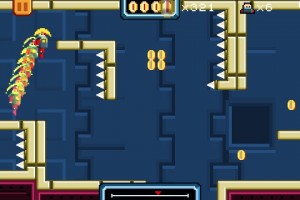 Super Bit Dash has undergone some pretty dramatic changes from your original vision, hasn’t it? What made the Fakepup team decide it would be worth the risk of extended development time to overhaul the graphics and presumably other aspects of the game’s design?
Super Bit Dash has undergone some pretty dramatic changes from your original vision, hasn’t it? What made the Fakepup team decide it would be worth the risk of extended development time to overhaul the graphics and presumably other aspects of the game’s design?
Afonso: We made a few changes to the game throughout its development state, but it was always because we weren’t completely happy with how the game looked or felt, and we don’t want to release a Fakepup game that we don’t feel really sure about any more.
Miguel Rafael: We have daytime jobs, so the only real risk was to never finish the game!
The sample audio track you released in June has a sequenced retro feel to it of course, but also a mood that’s very gritty, driving, futuristic and industrial. Does it reveal anything about the game’s world and atmosphere? And what software have you been using to compose Super Bit Dash’s soundtrack?
Miguel Rafael: Super Bit Dash‘s world and narrative are still pretty much open. We have no idea how the story will develop in the following updates, but one thing is sure: the heavy-beat soundtrack is already drilling into our minds and shaping the future of our dashing character’s story.
Miguel Cintra: The exciting thing about doing a retro and chip tune-influenced soundtrack is that these types of sounds, based on simple wave forms, do connect incredibly well with fast and punchy dance music. This was the perfect symbiosis to create the kind of world and atmosphere that this game needed.
To compose Super Bit Dash‘s soundtrack, I mainly used Logic Pro as the editor and mixer, with some audio units such as the Magical 8bit Plugin, developed by YMCK (a Japanese chip tune/pop-rock band); FM8 and Battery from Native Instruments; and lots of bitcrushing!
 We saw that you mentioned cocos2d last year on the Fakepup development blog. Did you end up sticking with cocos2d all the way? What about cocos2d made it a good choice for developing a side-scrolling game?
We saw that you mentioned cocos2d last year on the Fakepup development blog. Did you end up sticking with cocos2d all the way? What about cocos2d made it a good choice for developing a side-scrolling game?
Afonso: We’re using cocos2d for the iOS version and cocos2d-x for the Android version. We’ll eventually just use cocos2d-x for both versions, since it’s not very practical to maintain the two versions. We’re using cocos2d because it’s a very good framework with great support, well documented, has a great community behind it, and on top of it all, open source.
It appears you were originally hoping to release Super Bit Dash with a level editor for players to toy with, but had to cut back on that plan. Why did you decide to hold off on including the level editor, and do you think you might introduce it in an update sometime after release?
Afonso: The level editor wasn’t originally made to be released, actually — it was only supposed to be used internally. Right now the editor is far from user-friendly and there’s no documentation on how to use it. If enough people want the editor we’ll consider further developing it and releasing it in a future update.
iFanzine extends a huge thanks to Afonso Cordeiro, Miguel Cintra and Miguel Rafael for taking part in this interview. Let’s leave you with that preview footage again, and don’t forget our hands-on preview!
Be sure to hit up Fakepup’s dev blog and Twitter account for the latest updates. And naturally, check back with iFanzine for a verdict the moment Super Bit Dash hits the App Store!


